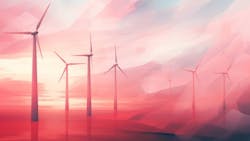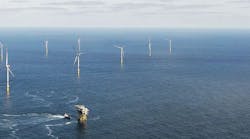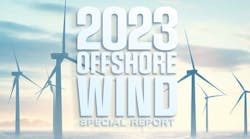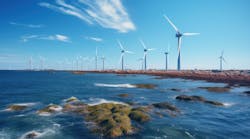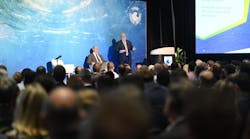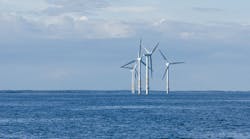By Ariana Hurtado, Editor and Director of Special Reports
HOUSTON — McKinsey says technologies with the fastest expected growth are the ones most vulnerable to bottlenecks, such as wind and solar. The offshore wind sector, in particular, has seen a decline in growth in Europe and the US. This article reviews the highs and lows the offshore wind sector has witnessed over the years, and where it stands now.
"The offshore wind industry looks back at an exciting decade of growth, maturation, value creation and ever-increasing government targets," Jakub Zivansky, partner and global leader of McKinsey’s Offshore Wind Hub, told Offshore.
That evolution of the offshore wind sector includes, according to Zivansky:
- Capacity growth: The industry grew from 3 GW in 2010 to 60+ GW installed capacity (including China), which produces enough electricity to power a mid-sized country.
- Fundamental characteristics: Offshore wind has been seen by a large body of policymakers and energy transition leaders as integral in achieving the energy transition—being scalable, complementary to other renewables generation sources, close to costal load centers, and a clean source of energy, Zivansky explained.
- Competitive cost: Levelized cost of electricity has been reduced from ~200 to ~80 USD/MWh over 2010-2022 for offshore wind driven by technology development and industrialization.
- Value creation: The industry has experienced attractive value creation along the value chain, he said, partly driven by government subsidies. Plus, 2030 government targets have grown to 400+ GW (including China).
Unfortunately, the offshore wind sector hasn't kept up a good momentum.
Sector sees decline
"In the current macro environment, offshore wind is hard hit; growth is slowing down in Europe and the US," he added.
Part of this is due to macroeconomic pressures. "Increasing interest rates and raw material costs have negatively impacted offshore wind projects," Zivansky said. "This has led to the cancellation or delay of many projects, with only about ~20% of capacity (based on a set of announced projects) planned last year to have been financially approved and moved forward, across both emerging markets like the US and more established offshore wind markets, especially Europe."
Another reason the sector has slowed down is because of profitability concerns. "With challenges stemming from supply chain bottlenecks and competitive developer behavior in a global arena (with over 60 players participating), the industry is facing a potential low profitability scenario due to capex inflation and rising interest rates," Zivansky explained. "When we look at levelized cost of electricity for offshore wind, it has increased more than that of onshore wind or solar on a per MWh basis given the different cost structures of these technologies."
Lastly, he said fundamentals remain. "However, offshore wind remains integral in achieving a clean energy mix in many places given limited scalability of other renewables solutions," Zivansky said. "Based on our modeling and due to its baseload-like and complementary profile, offshore wind can actually reduce average electricity cost of a decarbonized power system as it decreases the need to overbuild other technologies such as energy storage."
He said when and how offshore wind development will re-emerge into structural profitability will depend on several drivers. There are a wide range of possible outcomes with influences that include position in cost curve, regulatory frameworks, market pull, supply chain and developer behavior.
Position in cost curve
"Can offshore wind cost come back down quickly to fundamentally attractive levels? We are seeing prolonged difficulties, with higher commodity prices following onset of the war in Ukraine, interest rates and inflation. Convergence in cost position closing the gap to alternative sources is thus rather slow," Zivansky explained.
4C Offshore, a TGS company, downgraded its forecast in October for development of global offshore wind capacity by nearly 25% over the next four years. According to the consultant, steeply rising capital costs, inflation and supply chain disruption are leading developers to delay their projects.
4C's analysis of 113 offshore wind projects found that a planned 15 GW was under financial stress, in particular for power offtake contracts secured between 2019 and 2022. A further 10.9 GW could also be at risk, although the developers in these cases have not yet signaled concerns. The situation is delaying projects with a decline in offshore wind projects getting underway for installation between 2023 and 2027. The outlook for 2030 is better, 4C reported, due to long-term demand and strong fundamentals.
Regulatory frameworks
"Will support frameworks be adapted to ensure targets are met, or will governments live with a lower build-out pace? Regulatory bodies have in some places made announcements favorable for offshore wind, for example in the case of the upcoming auction round in the United Kingdom," Zivansky said.
As another example, Poland has set a national goal to generate 11 GW of power from offshore wind by 2040. The Polish offshore wind sector has seven projects totaling a capacity of 5.9 GW. According to renewable energy consultancy and service provider Natural Power, "These early milestones are bolstered by the Polish government's strategic decisions, including regulations promoting electricity generation in offshore wind farms, procedural improvements for quicker project implementation and a spatial development plan designating 2.34 thousand sq km for offshore wind farm construction."
Market pull
"Will customer segments drive demand for offshore wind given broader decarbonization regulation, for example RED3 [Renewable Energy Directive] and CBAM [Carbon Border Adjustment Mechanism] in Europe? There is emerging demand for green power among transition technology adopters, but market pull is still contingent on costs," Zivansky said.
RED III is a legal framework that aims to increase the share of renewable energy in the EU’s overall energy consumption to 42.5% by 2030. The directive was revised in 2023 and entered into force on Nov. 20, 2023.
CBAM is a carbon border tax created by the EU to reduce carbon emissions. It aims to address carbon leakage and offshoring emissions.
There are several measures that the UK government can take to realize decarbonization projects like floating wind, and Norway and the UK have looked to incentivize decarbonization projects through the tax system. Recently, Odfjell Oceanwind explained how the tax system could be an effective tool to achieve decarbonization.
Supply chain
Earlier this month, EY reported that the offshore wind industry has experienced a difficult 12 months, challenged by a squeezed supply chain and escalating costs. Global project costs have risen by 39% since 2019, and the next decade could see cost inflation adding about $280 billion in capex for the sector. EY said about 80% of the 15 markets with offshore wind targets for 2030 are predicted to miss their stated goals.
"Can supply-chain bottlenecks be overcome in time? Can suppliers and developers better share risks in supply chain capacity ramp-ups? Unfortunately we see suppliers challenged with continuous bottlenecks and difficulties to sign off on investments given some continued uncertainties on the pace of buildout," Zivansky added.
For instance, over the past few months, several developers and governments have announced delays or potential cancellations of projects in the UK and Denmark. The causes include increasing development costs, difficulty in securing desirable offtake deals and regulatory changes, Rystad Energy reported. As a result, these two nations are now expected to miss their 2030 offshore wind targets by a larger margin than previously anticipated, Rystad said. For example, the UK is now expected to reach a maximum of 46.8 GW of offshore wind capacity by 2030, missing its governmental target of 50 GW. Similarly, Denmark is now expected to reach slightly over 10 GW, below its target of 12 GW.
Developer behavior
"Will the current energy crisis trigger consolidation and higher financial discipline among developers? Here we see that developers have become more selective in market presence and some consolidation is happening," Zivansky said.
Take the Gulf of Mexico offshore wind auction as an example. In late August, RWE was the sole bidder for one of three leases auctioned in the region. Fifteen companies were qualified to bid during the sale, according to a BOEM document, yet the bidding was slow and low.
“The appetite is still there, we’re just in a small rough patch,” Samantha Woodworth, Wood Mackenzie’s senior research analyst, North America Wind, told Offshore in October.
12.15.2023
